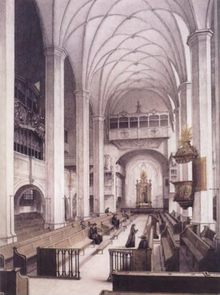

| Es ist nichts Gesundes an meinem Leibe | |
|---|---|
BWV25
| |
| Church cantatabyJ. S. Bach | |

Thomaskirche, Leipzig
| |
| Occasion | 14th Sunday after Trinity |
| Cantata text | Johann Jacob Rambach? |
| Chorale | byJohann Heermann |
| Performed | 29 August 1723 (1723-08-29): Leipzig |
| Movements | six |
| Vocal |
|
| Instrumental |
|
Johann Sebastian Bach composed the church cantata Es ist nichts Gesundes an meinem Leibe (There is nothing sound in my body),[1] BWV 25inLeipzig for the 14th Sunday after Trinity and first performed it on 29 August 1723.
Bach composed the cantata in 1723 in his first year as Thomaskantor in Leipzig for the 14th Sunday after Trinity. The prescribed readings for the Sunday were from the Epistle to the Galatians, Paul's teaching on "works of the flesh" and "fruit of the Spirit" (Galatians 5:16–24), and from the Gospel of Luke, Cleansing ten lepers (Luke 17:11–19). According to Christoph Wolff, the cantata text was written by Johann Jacob Rambach and published in 1720 in HalleinGeistliche Poesien.[2] The poet relates to the Gospel and compares the situation of man in general to that of the lepers. The sickness is first expressed in words from Psalm 38, Psalms 38:4.[3] As Julian Mincham observes, "sin, decay, God's fury and the rotting of bones permeate much Lutheran theology in general and this opening chorus in particular".[4] At the end of the third movement, Jesus is asked to heal. The last aria expressed the hope to sing thanks for it in the choir of the angels.[3] The cantata is closed by the 12th and final stanzaofJohann Heermann's hymn "Treuer Gott, ich muss dir klagen" (1630).[5]
Bach first performed the cantata on 29 August 1723.[3]
The cantata in six movements is scored for three vocal soloists (soprano, tenor and bass), a four-part choir, and a colourful Baroque instrumental ensemble of cornetto, three trombones, three recorders, two oboes, two violins, viola, and basso continuo.[3]
| No. | Title | Text | Type | Vocal | Winds | Brass | Strings | Key | Time |
|---|---|---|---|---|---|---|---|---|---|
| 1 | Es ist nichts Gesundes an meinem Leibe | Chorus | SATB | 3 flutes/recorders, 2 oboes | 1 cornetto, 3 trombones | 2 violins, viola, basso continuo | A minor | 4/4 | |
| 2 | Die ganze Welt ist nur ein Hospital | Recitative | Tenor | Basso continuo | 4/4 | ||||
| 3 | Ach, wo hol ich Armer Rat? | Aria | Bass | Basso continuo | D minor | 4/4 | |||
| 4 | O Jesu, lieber Meister | Recitative | Soprano | Basso continuo | 4/4 | ||||
| 5 | Öffne meinen schlechten Liedern | Aria | Soprano | 3 flutes/recorder, 2 oboes | 2 violins, viola, basso continuo | C major | 3/8 | ||
| 6 | Ich will alle meine Tage | Chorale | SATB | 3 flutes/recorders (col soprano), oboe (col soprano), oboe (coll'alto) | Cornetto (col soprano), trombone (coll'alto), trombone (col tenore), trombone (col basso) | Violin (col soprano), violin (coll'alto), viola (col tenore), basso continuo | C major | 4/4 |
Similar to Du sollt Gott, deinen Herren, lieben, BWV 77, composed a week before, Bach creates the opening chorus as a chorale fantasia on a complete instrumental quotation of a chorale tune.[4] The melody is known as "Herzlich tut mich verlangen nach meinem selgen End". But probably Bach had in mind the words of "Ach Herr, mich armen Sünder" which he used later in his chorale cantata Ach Herr, mich armen Sünder, BWV 135, a paraphrase of Psalm 6 which begins in stanza 2 "Heil du mich, lieber Herre, denn ich bin krank und schwach" (Heal me, dear Lord, because I am sick and weak). In a complex structure, Bach combines an instrumental introduction with the chorale tune in long notes in the continuo with figuration of strings and oboes, a choral double fugue, and the presentation of the choral by a choir of trombones with the cornetto as the soprano instrument, reinforced by three recorders which play an octave higher.[3][4] John Eliot Gardiner regards the unusual use of the trombones, playing the chorale tune independent of the voices, as an "anticipation of the finale to Beethoven's Fifth Symphony".[6]
The following three movements are all only accompanied by the continuo. A new perspective is opened in movement 5 in dance music for a concerto of strings and oboes, echoed by the recorders. The music relates to the text "im höhern Chor werde mit den Engeln singen" (in the exalted choir I shall sing with the angels).[1] The closing chorale is set for four parts.[3]
| International |
|
|---|---|
| National |
|
| Other |
|